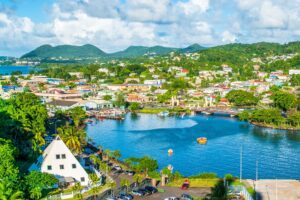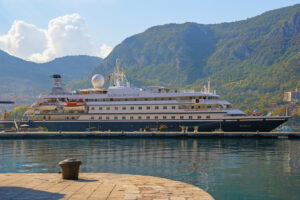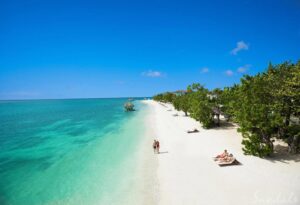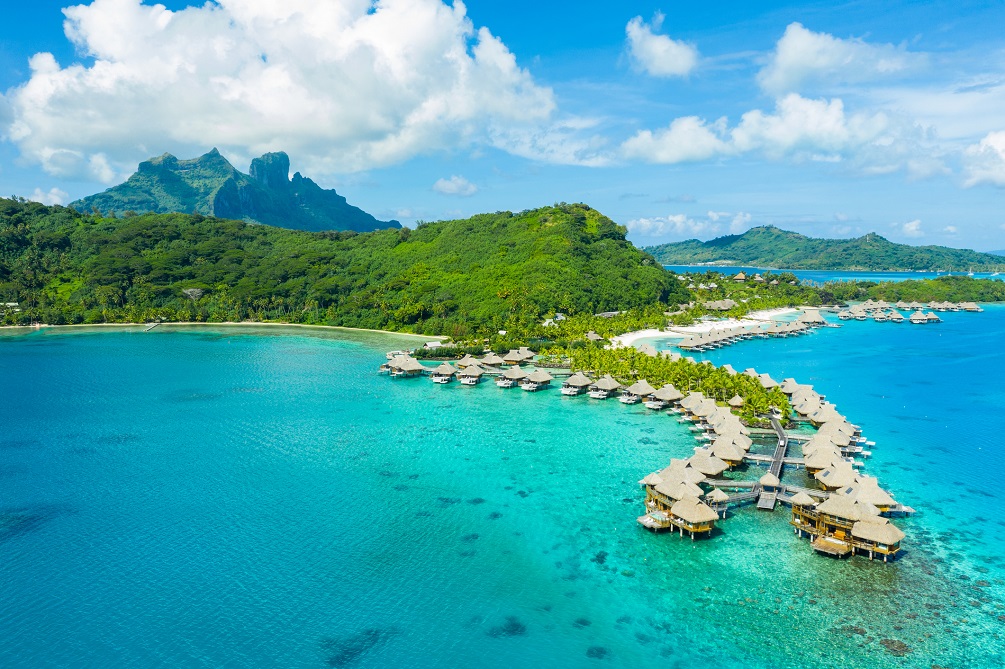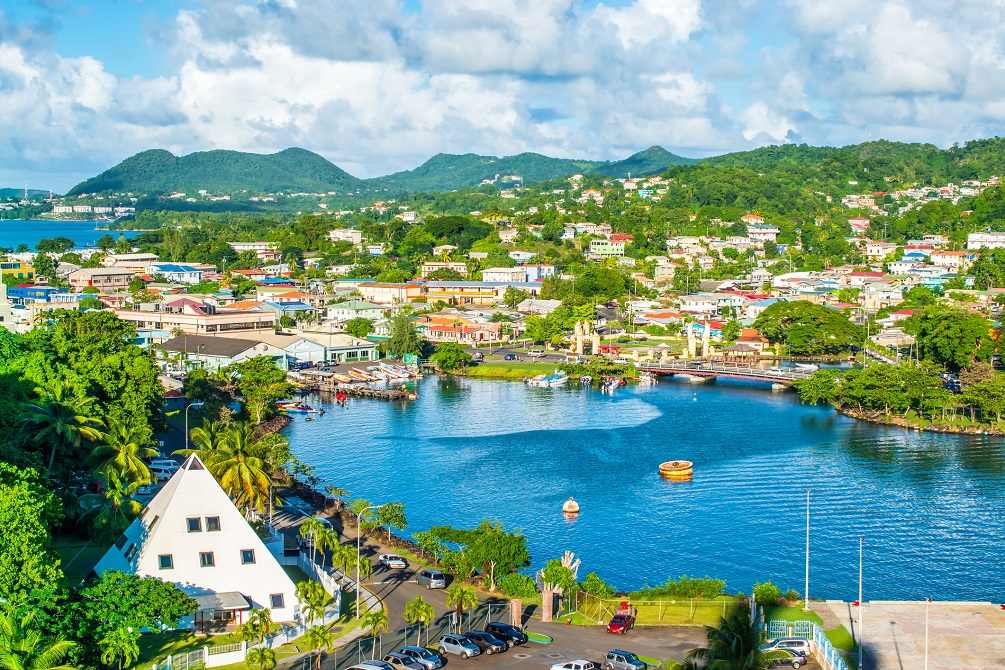St Lucia
From unique boutique hotels and luxury resorts to stunning scenery and exotic beaches, Saint Lucia is a Caribbean beauty that packs a lot of charm.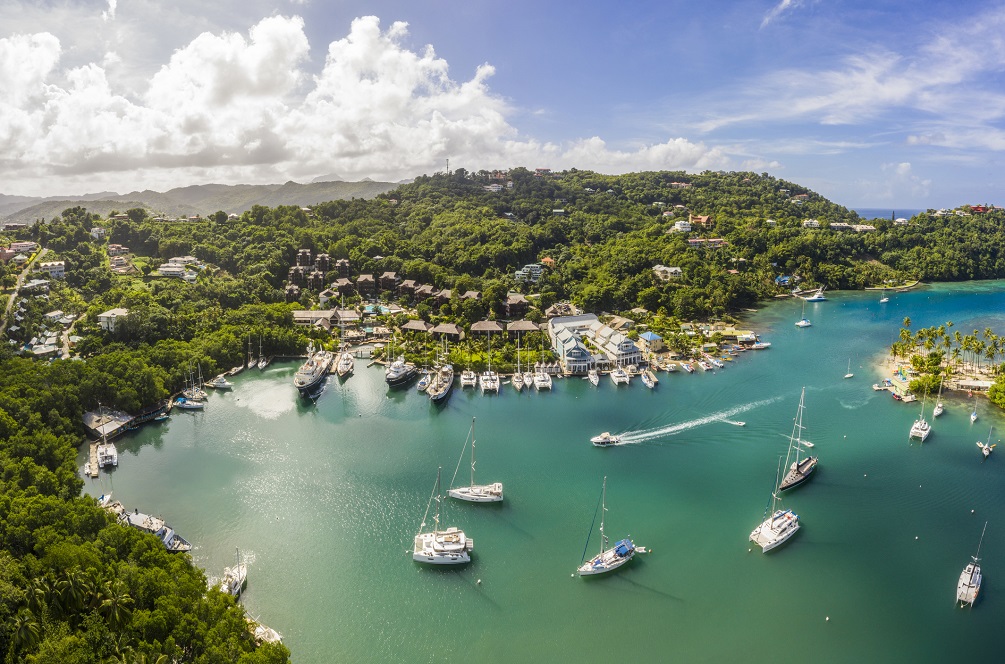
The island state of Saint Lucia, found in the Caribbean Sea, makes up for its small size with an abundance of charm. The island’s physical environment features towering mountains, luscious forests, and dazzling beaches.
A trip to Saint Lucia isn’t only an opportunity to explore the island’s heritage through historic sites, but also bask in nature. You can hike the Eastern Nature Trail along the Atlantic coastline or go zip lining. There are many beaches and lazy rivers to explore as well.
Whether you’re looking for a relaxing vacation or one filled with outdoor adventures, Saint Lucia makes it all possible. Food enthusiasts will not be disappointed on the island either. Prepare yourself for a culinary adventure featuring dishes like pepperpot and Saint Lucia’s take on conch.
The capital, Castries, is the commercial center of the island and over 30% of the population calls it home. The citizens of Saint Lucia speak Kwéyòl, a French Creole, and most are Christian.
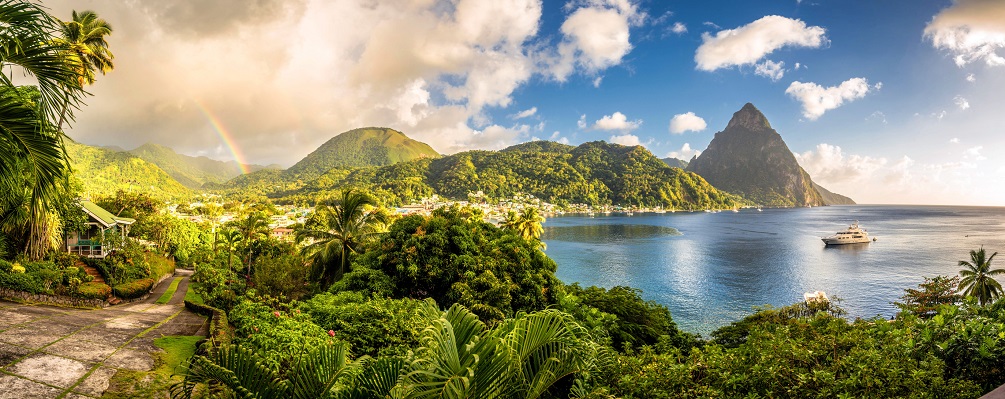


Unlike most Caribbean islands, Saint Lucia has a mountainous landscape, which reflects its volcanic origin. However, about 80% of the land surface is covered by forests.
The highest peak on the island is Mount Gimie (950 meters [3,120 feet]). Two other notable mountains on the western side of the island are the Pitons (Gros Piton and Petit Piton). They form a popular landmark between Soufrière and Choiseul that is a must-see when you visit Saint Lucia.
Several streams emerge from the mountains and flow through fertile valleys.
Nearby Soufrière lies another attraction: the boiling sulfur springs. This attraction is near Petit Piton, in the crater of an ancient volcano.
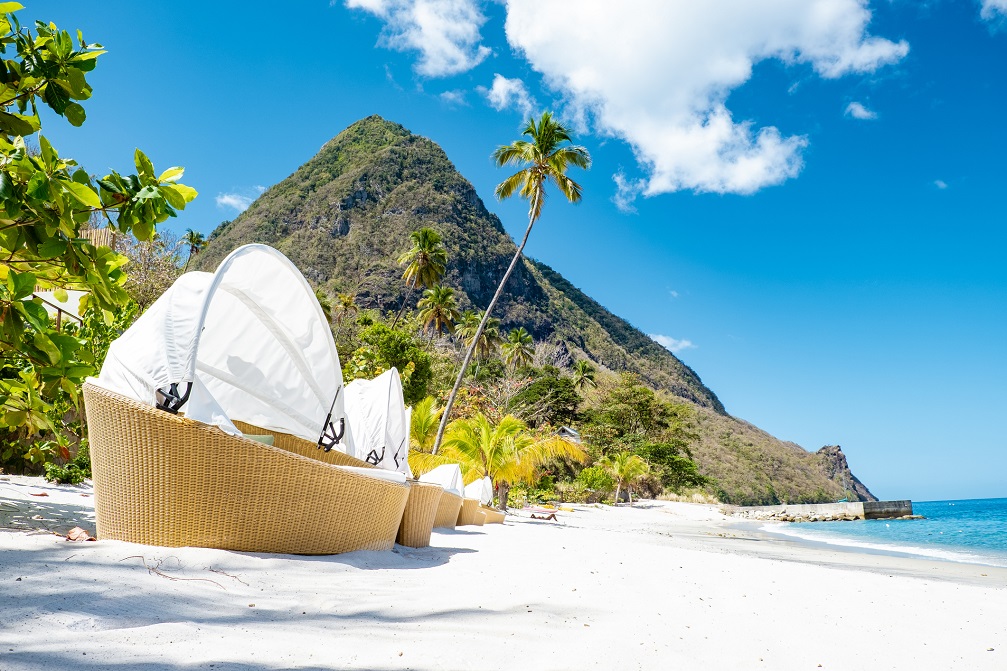


Saint Lucia experiences a tropical rainforest climate. The elevation across the island dictates the temperature and the amount of rainfall in each region.
The average daytime temperatures are about 30 °C (86.0 °F) and the night-time temperatures are around 24 °C (75.2 °F). There aren’t major temperature variations across the island between winter and summer.
The mountain rainforests in the interior receive an average of 3,810 mm (150 in). The coastal areas receive less precipitation, with an annual average of 1,300 mm (51.2 in).
The island’s wet season lasts roughly from 1 June to 30 November, while the dry season is from 1 December to 31 May. Locals refer to the wet season as hurricane season.
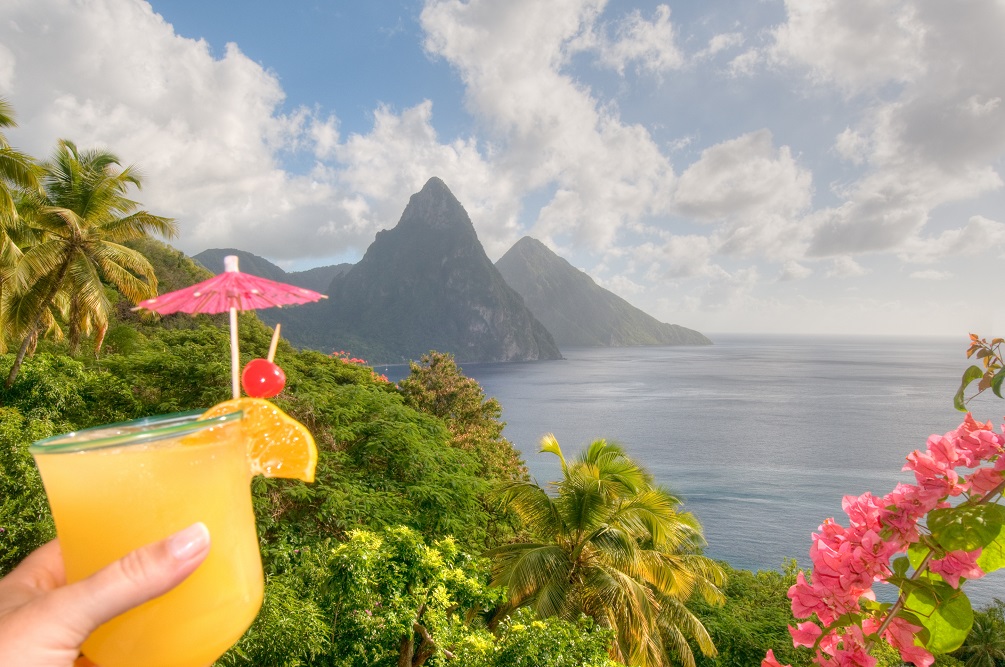


You’ll have a culinary adventure like no other in Saint Lucia. Many visitors find the island’s cuisine to be an irresistible combination of flavor, variety, and creativity.
Most of the traditional Saint Lucian dishes comprise seafood, peppers, yams, cassava, guavas, chives, and celery. Some meals are infused with nutmeg and cloves, owing to the island’s British and French heritage.
The national dish of the island is green bananas and salt fish, which is locally known as green figs and saltfish. It comprises cooked salted cod and unripe bananas that are boiled, then sautéed with vegetables and spices.
Bouyon is a traditional hearty and flavorsome soup you can have at almost any restaurant in Saint Lucia. It’s made from various meats such as beef, pork, saltfish, and lamb and combined with vegetables.
Lambi is Saint Lucia’s version of conch. The dish is often made Creole style, featuring many spices. This traditional dish is a must-have when visiting Saint Lucia.
Other traditional meals include pepperpot, Black pudding (Boudin), and smoked herring and breadfruit. Some side dishes worth trying include Pemmie, fried plantains, and cassava bread.
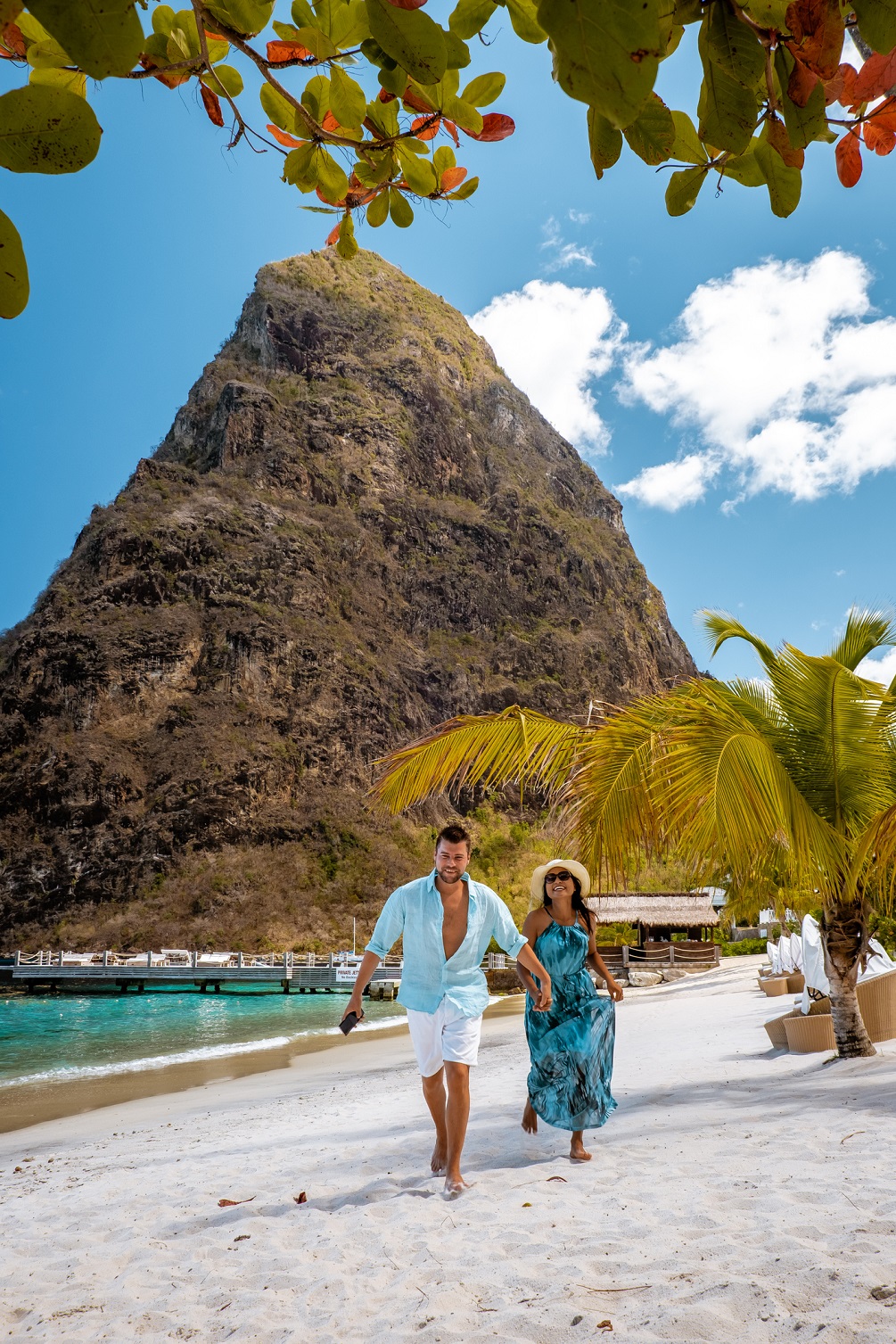


Figuring out what to pack for your trip to Saint Lucia is simple. Given the pleasant island weather, you have a good idea of what to bring.
Weather-appropriate, lightweight garments are best. This includes linen shorts, khakis, and cotton tank tops or t-shirts. If you’re going out to dinner in the evenings, you will have to dress more formally. Men should wear a button-down shirt and trousers, while pants or a sundress is ideal for women.
You should check with your hotel or resort for additional dress code requirements.
The weather in Saint Lucia is warm throughout the year. June through November are the warmest months. The evenings in coastal areas can be chilly and breezy, so bring along a light jacket or a sweater.
On Saint Lucia’s beaches, you are free to wear whatever swimwear you want. A cover-up like a sarong, pashmina, or oversized t-shirt is a great addition to any beachwear. Avoid wearing swimwear away from the beach.
If you’re traveling to Saint Lucia during the rainy months in summer, pack a light rain jacket. Also, instead of bringing rubber flip-flops opt for a comfortable pair of sneakers or sandals. Note that it’s illegal to wear any kind of army or camouflage print on the island.



The Eastern Caribbean dollar (XCD) is used to pay for goods and services in Saint Lucia. The XCD is divided into 100 cents.
Take along pounds and exchange them for the local currency instead of traveling with XCD. You can exchange your money at booths at the airport, at your hotel or resort, and at a local bank.
The US dollar is widely accepted on the island. You can use it to pay for accommodation, excursions, and hiring cars. Alternatively, you can make these purchases with XCD or a major credit card. Most hotels, car-rental agencies, restaurants, and shops accept Visa and MasterCard.
You can withdraw XCD from ATMs at bank branches and shopping centers throughout Saint Lucia.



English is the official language of the island, but a great majority of natives speak Saint Lucian French Creole (Kwéyòl). The creole has elements of French, West African languages, and Island Carib language.
Because Kwéyòl is spoken by approximately 95% of the population in Saint Lucia, knowing a bit of the language will help you get by. Here are some common Kwéyòl words and phrases for travel in Saint Lucia.
- Hello/good morning – Bonjou
- Good evening/good night – Bonswè
- Good afternoon – Bonnapwémidi
- How are you? – Kouman ou yé?
- I’m fine, and you? – Mwen byen, é ou menm?
- Yes – Wi
- No – Non
- Thank you – Mèsi
- Please – Souplé



African, East Indian, French, and English cultures have influenced Saint Lucia’s heritage. This is reflected in the local language and the island’s cuisine.
Indigenous folk music is integral to Saint Lucian’s. Caribbean music genres such as salsa, Soca, dancehall, calypso, and zouk are popular around the island.
The people of the island host several festivals year-round. The most notable of which is the Saint Lucia Jazz Festival. In early May, the festival attracts several visitors and musicians from around the world.
Cricket and sailing are prominent in Saint Lucia’s sports culture.
The majority religion on the island is Roman Catholicism, with Protestantism in the minority. The religious climate is accepting.



British nationals don’t need a visa to travel to Saint Lucia. When you arrive in the country, you’ll be given a period to stay.
For a longer stay, you must apply for an extension. You will also need to make a payment. All extensions should be done through the Saint Lucia Immigration Department.
There aren’t many requirements for passport validity. At a minimum, your passport should be valid for the duration of your stay on the island.



The power plugs and sockets in Saint Lucia are type G (triangular with three flat prongs).
Sockets supply a voltage of 240 V. The standard frequency is 50 Hz. Since the standard voltage in the UK is 230 V, you can use your electric appliances in Saint Lucia without a voltage converter.
Bring along a universal adaptor with surge protection for hot tools and hairdryers.



The island state of Saint Lucia, found in the Caribbean Sea, makes up for its small size with an abundance of charm. The island’s physical environment features towering mountains, luscious forests, and dazzling beaches.
A trip to Saint Lucia isn’t only an opportunity to explore the island’s heritage through historic sites, but also bask in nature. You can hike the Eastern Nature Trail along the Atlantic coastline or go zip lining. There are many beaches and lazy rivers to explore as well.
Whether you’re looking for a relaxing vacation or one filled with outdoor adventures, Saint Lucia makes it all possible. Food enthusiasts will not be disappointed on the island either. Prepare yourself for a culinary adventure featuring dishes like pepperpot and Saint Lucia’s take on conch.
The capital, Castries, is the commercial center of the island and over 30% of the population calls it home. The citizens of Saint Lucia speak Kwéyòl, a French Creole, and most are Christian.



Unlike most Caribbean islands, Saint Lucia has a mountainous landscape, which reflects its volcanic origin. However, about 80% of the land surface is covered by forests.
The highest peak on the island is Mount Gimie (950 meters [3,120 feet]). Two other notable mountains on the western side of the island are the Pitons (Gros Piton and Petit Piton). They form a popular landmark between Soufrière and Choiseul that is a must-see when you visit Saint Lucia.
Several streams emerge from the mountains and flow through fertile valleys.
Nearby Soufrière lies another attraction: the boiling sulfur springs. This attraction is near Petit Piton, in the crater of an ancient volcano.



Saint Lucia experiences a tropical rainforest climate. The elevation across the island dictates the temperature and the amount of rainfall in each region.
The average daytime temperatures are about 30 °C (86.0 °F) and the night-time temperatures are around 24 °C (75.2 °F). There aren’t major temperature variations across the island between winter and summer.
The mountain rainforests in the interior receive an average of 3,810 mm (150 in). The coastal areas receive less precipitation, with an annual average of 1,300 mm (51.2 in).
The island’s wet season lasts roughly from 1 June to 30 November, while the dry season is from 1 December to 31 May. Locals refer to the wet season as hurricane season.



You’ll have a culinary adventure like no other in Saint Lucia. Many visitors find the island’s cuisine to be an irresistible combination of flavor, variety, and creativity.
Most of the traditional Saint Lucian dishes comprise seafood, peppers, yams, cassava, guavas, chives, and celery. Some meals are infused with nutmeg and cloves, owing to the island’s British and French heritage.
The national dish of the island is green bananas and salt fish, which is locally known as green figs and saltfish. It comprises cooked salted cod and unripe bananas that are boiled, then sautéed with vegetables and spices.
Bouyon is a traditional hearty and flavorsome soup you can have at almost any restaurant in Saint Lucia. It’s made from various meats such as beef, pork, saltfish, and lamb and combined with vegetables.
Lambi is Saint Lucia’s version of conch. The dish is often made Creole style, featuring many spices. This traditional dish is a must-have when visiting Saint Lucia.
Other traditional meals include pepperpot, Black pudding (Boudin), and smoked herring and breadfruit. Some side dishes worth trying include Pemmie, fried plantains, and cassava bread.



Figuring out what to pack for your trip to Saint Lucia is simple. Given the pleasant island weather, you have a good idea of what to bring.
Weather-appropriate, lightweight garments are best. This includes linen shorts, khakis, and cotton tank tops or t-shirts. If you’re going out to dinner in the evenings, you will have to dress more formally. Men should wear a button-down shirt and trousers, while pants or a sundress is ideal for women.
You should check with your hotel or resort for additional dress code requirements.
The weather in Saint Lucia is warm throughout the year. June through November are the warmest months. The evenings in coastal areas can be chilly and breezy, so bring along a light jacket or a sweater.
On Saint Lucia’s beaches, you are free to wear whatever swimwear you want. A cover-up like a sarong, pashmina, or oversized t-shirt is a great addition to any beachwear. Avoid wearing swimwear away from the beach.
If you’re traveling to Saint Lucia during the rainy months in summer, pack a light rain jacket. Also, instead of bringing rubber flip-flops opt for a comfortable pair of sneakers or sandals. Note that it’s illegal to wear any kind of army or camouflage print on the island.



The Eastern Caribbean dollar (XCD) is used to pay for goods and services in Saint Lucia. The XCD is divided into 100 cents.
Take along pounds and exchange them for the local currency instead of traveling with XCD. You can exchange your money at booths at the airport, at your hotel or resort, and at a local bank.
The US dollar is widely accepted on the island. You can use it to pay for accommodation, excursions, and hiring cars. Alternatively, you can make these purchases with XCD or a major credit card. Most hotels, car-rental agencies, restaurants, and shops accept Visa and MasterCard.
You can withdraw XCD from ATMs at bank branches and shopping centers throughout Saint Lucia.



English is the official language of the island, but a great majority of natives speak Saint Lucian French Creole (Kwéyòl). The creole has elements of French, West African languages, and Island Carib language.
Because Kwéyòl is spoken by approximately 95% of the population in Saint Lucia, knowing a bit of the language will help you get by. Here are some common Kwéyòl words and phrases for travel in Saint Lucia.
- Hello/good morning – Bonjou
- Good evening/good night – Bonswè
- Good afternoon – Bonnapwémidi
- How are you? – Kouman ou yé?
- I’m fine, and you? – Mwen byen, é ou menm?
- Yes – Wi
- No – Non
- Thank you – Mèsi
- Please – Souplé



African, East Indian, French, and English cultures have influenced Saint Lucia’s heritage. This is reflected in the local language and the island’s cuisine.
Indigenous folk music is integral to Saint Lucian’s. Caribbean music genres such as salsa, Soca, dancehall, calypso, and zouk are popular around the island.
The people of the island host several festivals year-round. The most notable of which is the Saint Lucia Jazz Festival. In early May, the festival attracts several visitors and musicians from around the world.
Cricket and sailing are prominent in Saint Lucia’s sports culture.
The majority religion on the island is Roman Catholicism, with Protestantism in the minority. The religious climate is accepting.



British nationals don’t need a visa to travel to Saint Lucia. When you arrive in the country, you’ll be given a period to stay.
For a longer stay, you must apply for an extension. You will also need to make a payment. All extensions should be done through the Saint Lucia Immigration Department.
There aren’t many requirements for passport validity. At a minimum, your passport should be valid for the duration of your stay on the island.



The power plugs and sockets in Saint Lucia are type G (triangular with three flat prongs).
Sockets supply a voltage of 240 V. The standard frequency is 50 Hz. Since the standard voltage in the UK is 230 V, you can use your electric appliances in Saint Lucia without a voltage converter.
Bring along a universal adaptor with surge protection for hot tools and hairdryers.
Travel related news, information and inspirational articles and videos for travellers booking flights or holidays to St Lucia. Ask questions about travel in St Lucia and get answers from St Lucia experts
NEWS
Inspiration, Information and Travel Guides
MEET THE St Lucia EXPERTS
If you are looking to book a holiday to St Lucia or needs some help and advice planning travel to St Lucia then contact one of the UK based independent travel agents that specialise in St Lucia itineraries.
FEATURED VIDEOS
Your Travel Questions Answered
Ask any travel related question and get an answer from one of our experts that will provide you with an answer from their personal experience
There is no question for this category.

